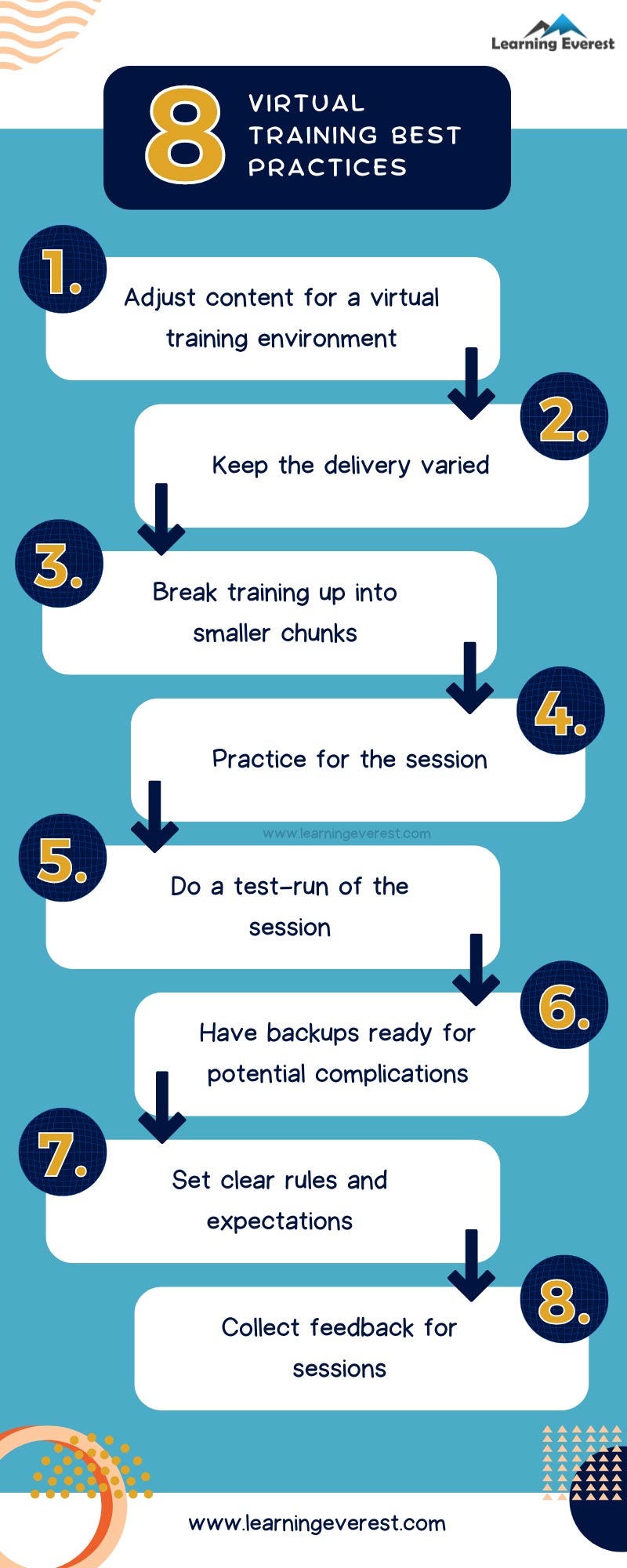Being mindful of and adhering to virtual training best practices can significantly elevate the quality and atmosphere of your sessions. Better sessions mean better learning, making it a top priority for instructors to use their best tools and strategies to develop virtual training programs. This article will introduce you to 8 of the most important virtual training best practices so you can take your programs to the next level.
Table of Contents
Essential Virtual Training Best Practices
Adjust content for a virtual training environment
One of the most essential virtual training best practices is to tailor the training content for a virtual training environment. What works in a face-to-face session might not necessarily work in a virtual training session, for instance, a basic slide-deck. Hence, use training strategies that are effective in virtual training environments, such as using multiple camera angles, presenting mostly digital content, providing learners with online resources, etc.
Keep the delivery varied
You should also keep training delivery varied. Use a mix of mediums, such as text, graphics, videos, discussions, activities, worksheets, etc., to prevent sessions from becoming too monotonous. Keeping the delivery format varied also lets you combine training material with strategies that are best suited to them. For instance, presenting statistics with a graph as opposed to just numbers or showing video or live demonstrations of complex processes instead of just verbally explaining them.
Break training up into smaller chunks
Another virtual training best practice is to break individual training sessions into smaller chunks. Structure your training in such a way that there are breaks that change the pace of the session. If you only deliver information to learners for a long stretch, it will lead to fatigue, information overload, and boredom. To break training up into smaller chunks you can do the following:
- Create breakout room activities
- Have question-and-answer rounds
- Play learning or ice-breaking games
- Schedule activities
- Hold quizzes
Practice for the session
It is also advised not to go into sessions unprepared, no matter how thorough you might be with the training topic. Practice how you will deliver it beforehand, recite the script, structure how you will frame your words and thoughts, rehearse quiz activities, practice explaining concepts and answering questions, etc. Practicing for a session elevates its quality, making it a more seamless and meaningful learning experience for learners. Additionally, practice increases your value and reputation as a trainer as it communicates that you are professional, knowledgeable, and thorough.
Do a test-run of the session
You can prepare even more thoroughly for virtual training sessions by doing a test-run in advance to check and adjust settings, troubleshoot, and solve any potential problems you might be running into. This ensures that the actual session starts and ends on time and doesn’t see any unexpected challenges that you are not prepared to deal with quickly.
Have backups ready for potential complications
Apart from practice and test-runs, have backups for key equipment ready. These can include an extra laptop with the training content stored in it, extra earphones and mics, a spare charger, portable wi-fi, a backup mouse or remote, extra batteries, etc.
Set clear rules and expectations
Another virtual training best practice is to set clear rules and expectations for the session. Let participants know of how they are supposed to conduct themselves during the session (for example, cameras on, mics off except when speaking, raising hand to speak or ask questions, etc.) Also brief participants on the session’s overall structure and delivery. It is important to share clear and measurable learning objectives at the start of the session so learners know what to expect and get into the right learning mindset.
Collect feedback for sessions
Last but not least, collect learner feedback for each session. Use online surveys to gauge the following:
- Effectiveness of the session
- How engaging the session was
- The quality of the audio
- The quality of visual elements
- The structure and format of the training
- Instructor’s delivery, presentation, and personality
- Learners’ opinions on activities
- What learners found missing
- Learners’ suggestions and needs
Improve subsequent sessions based on the feedback you collect.
Benefits of Virtual Training Best Practices
Let us now look at the benefits of virtual training best practices.
- Following virtual training best practices increases the training effectiveness of your sessions
- Virtual training best practices make your sessions more polished and refined, leaving a better impression on learners
- Learners feel more confident about a well-planned and smoothly executed training session
- Following virtual training best practices improves learner engagement during the session
- Virtual training best practices increase learners’ retention of the training content
- Adhering to virtual training best practices ensures each session goes as planned, without wasting any time
Infographic
Knowledge Check!
Frequently Asked Questions (FAQs)
How to do effective virtual training?
Effective virtual training can be done by tailoring training to a virtual environment, keeping the session engaging using various strategies, and practicing and preparing thoroughly for the session to avoid unforeseen hitches.
How to make online training more interactive?
Online training can be made more interactive through activities, Q&A sessions, quizzes, breakout rooms, games, etc.
What makes an effective virtual class?
Following virtual training best practices makes an effective virtual class.






